Oracle® Enterprise Manager Ops Center
Lifecycle Management of Logical Domains
12c Release 3 (12.3.0.0.0)
E60036-01
June 2015
This guide provides an end-to-end example for how to use Oracle Enterprise Manager Ops Center.
Introduction
You can use Oracle Enterprise Manager Ops Center to provision Oracle VM Server for SPARC, create logical domains on them, and provision operating systems on the logical domains. You can also pool the Oracle VM Server for SPARC systems in a server pool which provides load balancing, high availability capabilities, and sharing resources with all the members of the pool.
Each logical domain can be created, destroyed, reconfigured, and rebooted independently, without requiring the server to be powered off. You can run a variety of applications in different logical domains to keep them independent for performance and security purposes.
You can create logical domains with the following subtypes in Oracle Enterprise Manager Ops Center:
-
Physical I/O domain: An I/O domain that has direct access to a physical I/O device, such as the PCIe Controller. The I/O domain shares the physical I/O device with other domains in the form of virtual devices.
-
Root domain: An I/O domain that has PCIe root complex assigned to it.
-
Guest domain: A non-I/O domain that has virtual devices such as virtual disks and virtual network interfaces.
-
HA Guest domain: A non-I/O domain with high availability provided by redundant network connections and redundant access to the virtual disk of the guest domain.
Roles assigned to a logical domain in Oracle Enterprise Manager Ops Center can be one or more of the following: io, guest, service, or root.
This example describes a set of basic operations to manage the lifecycle of a logical domain created in an Oracle VM Server for SPARC server pool. These actions will enable you to perform other management operations to the logical domain, such as connecting networks, adding storage, and modifying the configuration among other actions.
See Related Articles and Resources for links to related information and articles.
What You Will Need
You will need the following to manage your logical domains:
-
A user with the Virtualization Admin role.
-
Two agent-managed logical domain in running status created or discovered using Oracle Enterprise Manager Ops Center in an Oracle VM Server for SPARC server pool. In this example, you use two logical domains created in Oracle Enterprise Manager Ops Center, a guest and an I/O domain.
Lifecycle Management of Logical Domains
In this example, you use the Oracle Enterprise Manager Ops Center user interface (UI) to perform actions to manage the lifecycle of a logical domain. These actions are described in the following sections:
-
Identifying the Status of a Logical Domain – this section describes the available status for a logical domain, and how to verify its current status.
-
Basic Logical Domain Operations – this section describes how to reboot, shut down, start, and delete a logical domain. These operations are available to all logical domains regardless of its subtype. However, users have to be careful when rebooting or shutting down I/O domains and root domains when they provide virtual disk services to guest domains.
In this example, you use the logical domains named ldomVnet1 and iodom1 created in an Oracle VM Server for SPARC server pool named ldoms Pool.
Identifying the Status of a Logical Domain
In the Oracle Enterprise Manager Ops Center UI, you can see a logical domain in one of the following status:
-
Running – In this status, the logical domain is powered on and the OS is booted.
-
Shutdown/detached – In this status, the logical domain is shut down and disassociated from the control domain, disconnected from its networks and storage resources, and all the associated resources are released.
-
Shutdown – In this status, the logical domain is shut down but it still associated to the control domain, connected to its network and storage resources.
-
Installing – In this status, a logical domain was created and the job for OS and agent provisioning is still in progress or not yet installed.
-
Unreachable – In this status, the logical domain cannot be contacted for information. This status indicates a network problem or a problem with the logical domain or the control domain.
You can verify the status of a logical domain directly in the Navigation pane, or in the Dashboard page of the logical domain.
In the Navigation pane, one of the following icons is placed next to the logical domain to show its current status:
| Icon | Status |
|---|---|
| Running | |
| Shutdown or Shutdown/detached | |
| Installing | |
| Unreachable |
In the logical domain Dashboard page you can verify its current status along with other information of the logical domain such as operating system, tags, running time, or incidents.
To verify the status of a logical domain in the Dashboard page:
-
Expand Assets in the Navigation pane, then select Sever Pools from the list.
-
Select the logical domain listed under the ldoms Pool server pool in the Navigation pane.
-
Verify that the status of the logical domain is running.
The status is part of the information displayed in the Dashboard page of the logical domain.

Description of the illustration ldom_dashboard2.png
Basic Logical Domain Operations
This section covers the following operations:
Rebooting a Logical Domain
You can reboot a logical domain that is in the running status. You might want to perform a reboot after a system configuration change or any particular need for your applications.
When rebooting a logical domain of the I/O or root subtype, you need to be careful if they are providing virtual disk services to guest domains.
This example shows you how to reboot a running guest domain.
-
Expand Assets in the Navigation pane, then select Sever Pools from the list.
-
Select the logical domain listed under the server pool in the Navigation pane.
You can verify that the status of the logical domain is running.
-
Click Reboot in the Actions pane.

Description of the illustration ldom_actions.png
-
Click Reboot Logical Domain to confirm.

Description of the illustration ldom_rebootmsg.png
-
After the job completes, verify that the logical domain is in running status.

Description of the illustration ldom_dashboard2.png
Shutting Down a Logical Domain
You might want to perform a shut down for a system configuration change or any particular need for your applications. You can use the Shutdown / Detach action to perform one of the following actions:
-
Shutting down a logical domain – The status of the logical domain is changed to shutdown. The logical domain is still associated with the control domain, and connected to its network and storage resources. When you start a shutdown domain, you are not required to define the server and the resources
-
Shutting down and detaching a logical domain – The status of the logical domain is changed to shutdown/detach. The logical domain is disconnected from its networks, disassociated from the control domain, and all the associated resources are released. To start the logical domain, you have to define and select the server, network, and storage resources. The option to shut down and detach a logical domain is not available for all logical domain subtypes.
The following sections are examples for:
-
Shutting Down and Detaching a Guest Domain – In this example, you shut down and detach a running logical domain created as a guest domain subtype in a server pool.
-
Shutting Down an I/O Domain – In this example, you shut down a running logical domain created as an I/O domain subtype in a server pool. When shutting down a logical domain of the I/O or root subtype, you need to be careful if they are providing virtual disk services to guest domains.
Shutting Down and Detaching a Guest Domain
-
Select the logical domain listed under the server pool in the Navigation pane.
You can verify that the status of the logical domain is running.
-
Click Shutdown / Detach in the Actions pane.

Description of the illustration ldom_actions.png
-
Review the information and click Next to continue.
In case the selected logical domain does not support the detach action, you will only have the option to shut down.
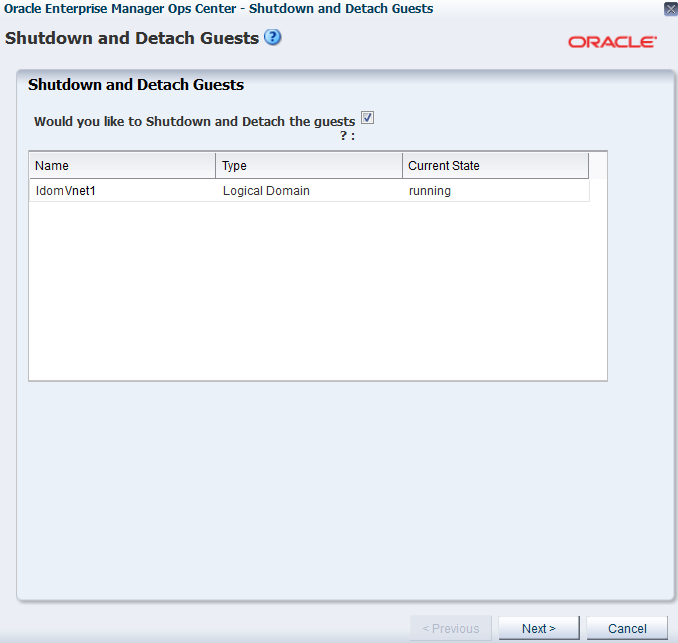
Description of the illustration ldom_shutdownmsg.png
-
Click Shutdown and Detach to confirm.
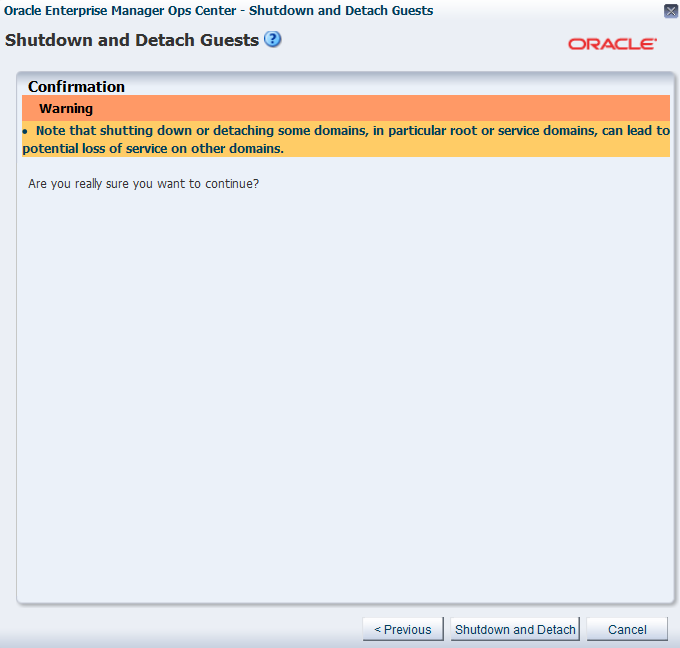
Description of the illustration ldom_shutdowndetached.png
-
Verify that the status of the logical domain is changed to shutdown/detached after the job completes.

Description of the illustration ldom_shutdowndetachpost.png
Shutting Down an I/O Domain
-
Select the logical domain listed under the server pool in the Navigation pane.
You can verify that the status of the logical domain is running.
-
Click Shutdown / Detach in the Actions pane.
-
Review the information and click Next to continue.
The action to detach is disabled for this logical domain, you can see warning message explaining the reason.
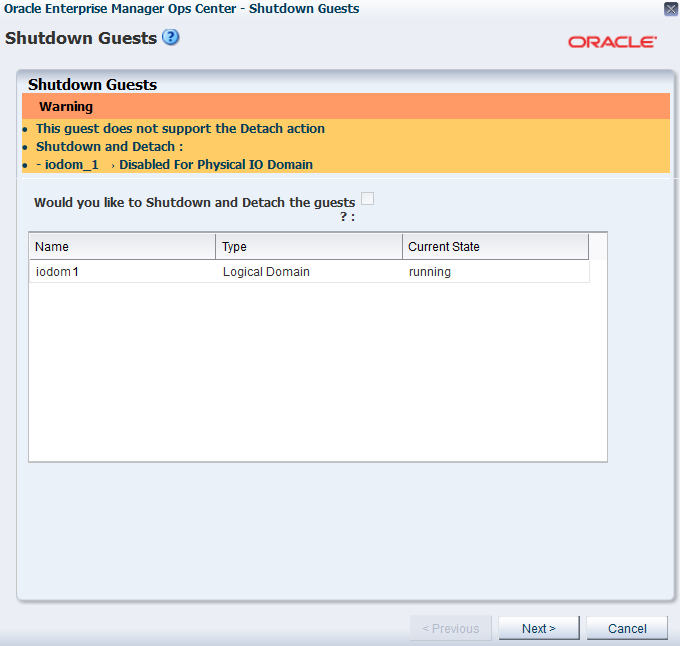
Description of the illustration ldom2_shutdownmsg.png
-
Click Shutdown to confirm.
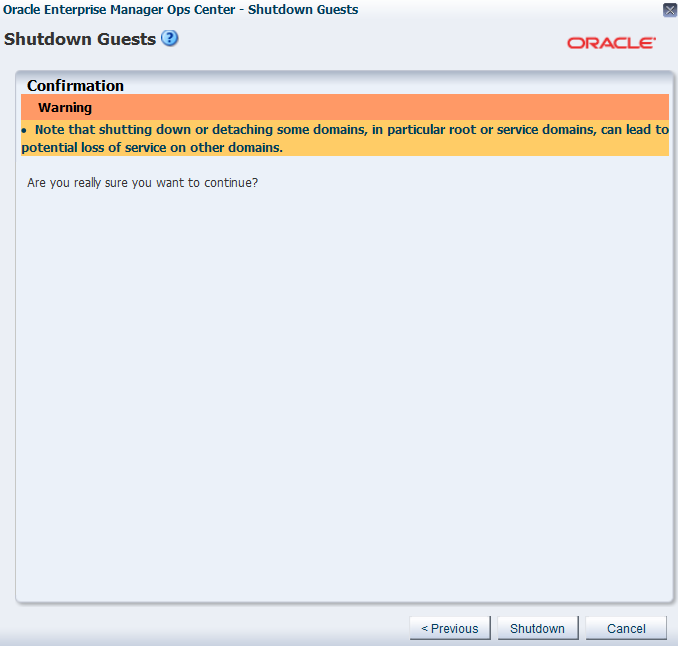
Description of the illustration ldom2_shutdownmsg2.png
-
Verify that the status of the logical domain is changed to shutdown after the job completes.

Description of the illustration ldom2_shutdownpost.png
Starting a Logical Domain
You can start a logical domain with the same configuration that is maintained in its storage library.
You can start a logical domain from a shutdown or shutdown and detached state.
The logical domain in shutdown state starts immediately in the same Oracle VM Server. When starting a logical domain is in shutdown and detached state, you need to define the Oracle VM server, network, and storage resources to start the logical domain. For a logical domain in shutdown and detached state placed in a server pool, you can also select a different server pool.
The following sections are examples for:
-
Starting a Shutdown Logical Domain: In this example, you start a shutdown logical domain created as an I/O domain subtype in a server pool
-
Starting a Shutdown and Detached Logical Domain: In this example, you shut down and detach a running logical domain created as a guest domain subtype in a server pool. This logical domains is connected to the network using virtual functions, by using the network interface from the control domain to connect to the network.
Starting a Shutdown Logical Domain
-
Select the shutdown logical domain listed under the server pool in the Navigation pane.
-
Click Start in the Actions pane.

Description of the illustration ldom_actions.png
-
Verify the status of the logical domains is changed to running after the job completes.
Starting a Shutdown and Detached Logical Domain
-
Select the logical domain listed under Shutdown Guests of the server pool in the Navigation pane.
You can verify that the status of the logical domain is shutdown/detached in the Dashboard page.

Description of the illustration ldom_shutdowndetachpost.png
-
Click Start in the Actions pane.

Description of the illustration ldom_actions.png
-
Select from the list the server pool to run the logical domain on, then click Next.

Description of the illustration ldom_startmsg.png
-
Select from the list the Oracle VM Server to host the logical domain, then click Next.
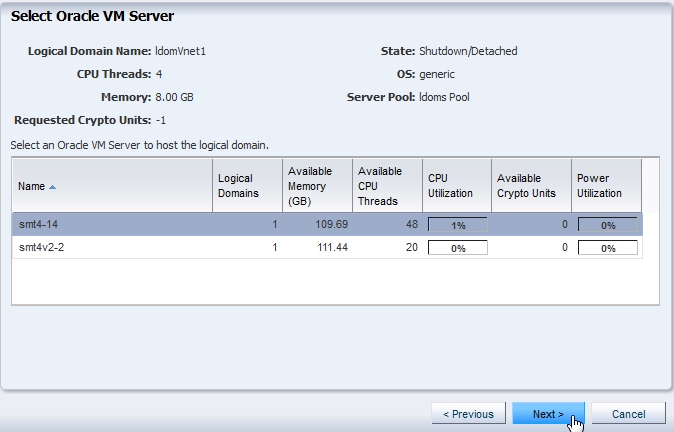
Description of the illustration ldom_startmsg2.png
-
Specify the virtual switch or virtual function through which you connect the logical domain MAC address to the network, then click Next.
In this example, you specify a virtual function by selecting primary as the service domain to use the network interface from the control domain to provide the network connection. Other available network interfaces from other I/O domains are listed in the Service Domain field with the respective names of the domains.
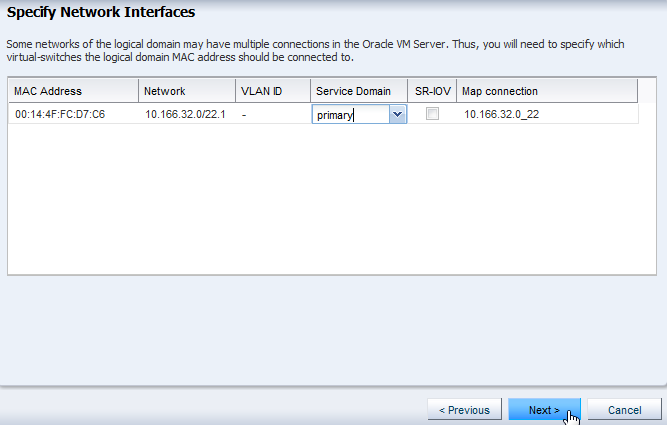
Description of the illustration ldom_startmsg3.png
-
Specify the storage devices for the logical domain, then click Next.
In this example, a virtual disk is specified for the logical domain. You also configure the virtual disk with multipathing by selecting primary-vds0 as Service Name to provide an alternate path to access the back-end storage through the control domain. Each path can be from a primary, I/O, or root domain and it is exposed as virtual disk servers in the control domain.
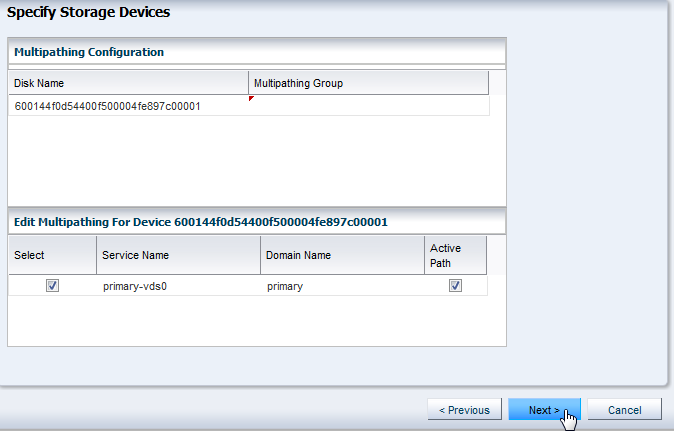
Description of the illustration ldom_startmsg4.png
-
Specify when you want to start the logical domain, then click Next.
In this step, the option to start the logical domain immediately is selected.
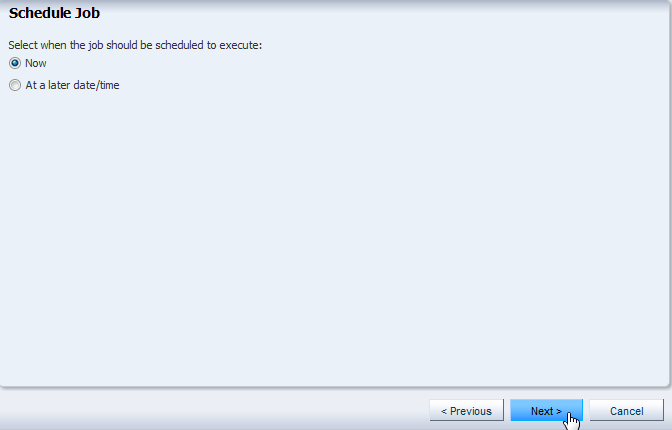
Description of the illustration ldom_startmsg5.png
-
Review the logical domain information, then click Finish.

Description of the illustration ldom_startmsg6.png
-
Verify that the status of the logical domain is changed to running after the job completes.
Deleting a Logical Domain
You can delete a running, installing, shutdown, or a shutdown/detached logical domain. When deleting a logical domain, the logical domain is disconnected from the associated networks and is disassociated from the control domain. All the associated resources are released and the domain configuration is removed from the library.
All the references to the logical domain, including disk image and snapshots are removed from the system. However, the logical domain profile and plan remain unaffected.
If the logical domain is a service domain that provides virtual I/O services to other running logical domains, then you cannot delete the logical domain.
Starting with the 12.2.2.0.0 release, you can use the Delete action to delete root domains that have virtual functions on SR-IOV enabled PCIe devices if other domains are not using a virtual function from that root domain. For previous releases, you must delete all the associated virtual functions created on the SR-IOV enabled PCIe devices before proceeding to delete the root domain, the virtual functions must be deleted manually in the reverse order from the command line prompt of the control domain.
This example shows you how to delete a guest domain in running status and without virtual functions assigned. If you want to delete guest domains assigned with virtual functions, you must first remove the virtual functions from the domain and then delete the guest domains.
-
Select the logical domain listed under the server pool in the Navigation pane.
You can verify that the status of the guest domain is running.
-
Click Delete in the Actions pane.

Description of the illustration ldom_actions.png
-
Click Delete Logical Domain to confirm.

Description of the illustration ldom_deletemsg.png
-
After the job completes, verify that the logical domain is no longer listed under the server pool in the Navigation pane.
What's Next?
You can perform logical domain configuration actions such as add storage, modify CPU and memory allocation, or connect networks.
Related Articles and Resources
The Oracle Enterprise Manager Ops Center 12c Release 3 documentation is available at http://docs.oracle.com/cd/E59957_01/index.htm.
For information about Oracle VMS Server for SPARC and server pools, see the Oracle Enterprise Manager Virtualize Reference.
For current discussions, see the product blog at https://blogs.oracle.com/opscenter.
See the Deploy How To library at http://docs.oracle.com/cd/E59957_01/nav/deploy.htm and the Operate How To library at http://docs.oracle.com/cd/E59957_01/nav/operate.htm for deployment and operational examples.
Documentation Accessibility
For information about Oracle's commitment to accessibility, visit the Oracle Accessibility Program website at http://www.oracle.com/pls/topic/lookup?ctx=acc&id=docacc.
Oracle customers that have purchased support have access to electronic support through My Oracle Support. For information, visit http://www.oracle.com/pls/topic/lookup?ctx=acc&id=info or visit http://www.oracle.com/pls/topic/lookup?ctx=acc&id=trs if you are hearing impaired.
Oracle Enterprise Manager Ops Center Lifecycle Management of Logical Domains, 12c Release 3 (12.3.0.0.0)
E60036-01
Copyright © 2007, 2015, Oracle and/or its affiliates. All rights reserved.
This software and related documentation are provided under a license agreement containing restrictions on use and disclosure and are protected by intellectual property laws. Except as expressly permitted in your license agreement or allowed by law, you may not use, copy, reproduce, translate, broadcast, modify, license, transmit, distribute, exhibit, perform, publish, or display any part, in any form, or by any means. Reverse engineering, disassembly, or decompilation of this software, unless required by law for interoperability, is prohibited.
The information contained herein is subject to change without notice and is not warranted to be error-free. If you find any errors, please report them to us in writing.
If this is software or related documentation that is delivered to the U.S. Government or anyone licensing it on behalf of the U.S. Government, then the following notice is applicable:
U.S. GOVERNMENT END USERS: Oracle programs, including any operating system, integrated software, any programs installed on the hardware, and/or documentation, delivered to U.S. Government end users are "commercial computer software" pursuant to the applicable Federal Acquisition Regulation and agency-specific supplemental regulations. As such, use, duplication, disclosure, modification, and adaptation of the programs, including any operating system, integrated software, any programs installed on the hardware, and/or documentation, shall be subject to license terms and license restrictions applicable to the programs. No other rights are granted to the U.S. Government.
This software or hardware is developed for general use in a variety of information management applications. It is not developed or intended for use in any inherently dangerous applications, including applications that may create a risk of personal injury. If you use this software or hardware in dangerous applications, then you shall be responsible to take all appropriate fail-safe, backup, redundancy, and other measures to ensure its safe use. Oracle Corporation and its affiliates disclaim any liability for any damages caused by use of this software or hardware in dangerous applications.
Oracle and Java are registered trademarks of Oracle and/or its affiliates. Other names may be trademarks of their respective owners.
Intel and Intel Xeon are trademarks or registered trademarks of Intel Corporation. All SPARC trademarks are used under license and are trademarks or registered trademarks of SPARC International, Inc. AMD, Opteron, the AMD logo, and the AMD Opteron logo are trademarks or registered trademarks of Advanced Micro Devices. UNIX is a registered trademark of The Open Group.
This software or hardware and documentation may provide access to or information about content, products, and services from third parties. Oracle Corporation and its affiliates are not responsible for and expressly disclaim all warranties of any kind with respect to third-party content, products, and services unless otherwise set forth in an applicable agreement between you and Oracle. Oracle Corporation and its affiliates will not be responsible for any loss, costs, or damages incurred due to your access to or use of third-party content, products, or services, except as set forth in an applicable agreement between you and Oracle.